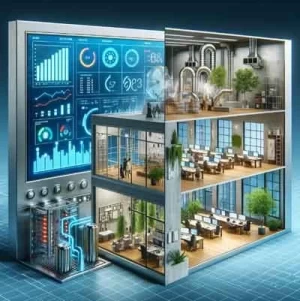Exploring the Rise of Cloud-Based BAS for Enhanced Energy Management

Building Automation Systems (BAS) have become a cornerstone for optimizing energy consumption in buildings. Traditionally, BAS have operated as on-premise systems, with hardware and software located within the building itself. However, the recent surge in cloud-based technologies has led to the rise of Cloud-Based BAS (CB-BAS), offering a new paradigm for building energy management. This article explores the advantages of CB-BAS solutions, delves into the impact on building management practices, and addresses security considerations associated with cloud deployments.
Visit Our Building Automation Study Course
Breaking the Physical Barrier: Advantages of Cloud-Based BAS
Cloud-based BAS offer several advantages over traditional on-premise systems, making them an attractive proposition for building owners and facility managers:
Scalability and Flexibility: CB-BAS are inherently scalable, easily adapting to changes in building size or the addition of new equipment. This flexibility eliminates the need for costly hardware upgrades or software licensing modifications as building needs evolve.
Remote Access and Management: CB-BAS empower building managers with remote access capabilities. System monitoring, data analysis, and configuration changes can be performed from any internet-connected device, offering greater control and convenience.
Improved Data Management and Analytics: Cloud-based platforms provide centralized storage for building data collected by the BAS. This facilitates comprehensive data analysis, allowing for identifying trends, optimizing energy consumption patterns, and making informed decisions regarding building operations.
Reduced Hardware Costs: CB-BAS eliminate the need for on-premise servers and associated hardware infrastructure, leading to significant cost savings on upfront investment. Additionally, with software licensing often based on a subscription model, ongoing IT maintenance costs can also be reduced.
Automatic Updates and Security Features: Cloud-based BAS providers typically handle system updates and security patches automatically, ensuring that building systems remain current and protected from potential vulnerabilities. This reduces the reliance on in-house IT staff for system maintenance.
Integration with Other Systems: CB-BAS can offer seamless integration with other cloud-based building management solutions, such as Computerized Maintenance Management Systems (CMMS) or tenant management platforms, allowing for a more holistic approach to building operations and optimization.
Building Management in the Cloud: Transforming Practices
The adoption of CB-BAS has a significant impact on how buildings are managed:
Proactive Maintenance and Fault Detection: Cloud-based analytics capabilities enable proactive maintenance practices. Real-time data analysis can identify potential equipment failures or inefficiencies before they escalate into major issues, allowing for preventative maintenance to be scheduled and downtime to be minimized.
Data-Driven Decision Making: The wealth of data collected and analyzed by CB-BAS empowers building managers to make data-driven decisions regarding building operations. Energy consumption patterns can be identified and optimized, leading to greater resource efficiency and cost savings.
Enhanced Collaboration and Communication: CB-BAS often offer user interfaces and communication features that facilitate collaboration among building stakeholders. Building owners, facility managers, maintenance personnel, and tenants can all access relevant data and communicate seamlessly, fostering a more streamlined management approach.
Security in the Cloud: Addressing Concerns
While CB-BAS offer a multitude of advantages, security considerations are paramount:
Data Security and Privacy: Sensitive building data collected by BAS, including energy consumption patterns and occupancy information, needs robust protection. CB-BAS providers should employ robust security protocols, including data encryption in transit and at rest, to safeguard sensitive information.
Network Security: Secure communication channels between building systems and the cloud platform are essential. Utilizing secure protocols like HTTPS and implementing robust authentication mechanisms can mitigate the risk of unauthorized access.
Vendor Lock-In: Some CB-BAS solutions may have limitations regarding interoperability with other systems or future upgrades. Choosing a CB-BAS provider with open communication protocols and a commitment to long-term system support can minimize vendor lock-in concerns.
Building Staff Training: Transitioning to a cloud-based BAS environment requires appropriate training for building staff. Understanding cybersecurity best practices and procedures for secure remote access is crucial for safeguarding the system and building data.
The Future of Building Management is in the Cloud
Cloud-based BAS offer a compelling solution for building owners and facility managers seeking to optimize energy consumption, improve operational efficiency, and embrace modern building management practices. By leveraging the scalability, remote access capabilities, and data analytics advantages of cloud technology, CB-BAS empower stakeholders to make informed decisions and achieve significant cost savings through improved energy management. While security considerations need to be addressed proactively, the benefits of CB-BAS outweigh the risks ffor organizations committed to sustainable building operations. As cloud technology continues to evolve and security protocols become even more robust, CB-BAS is poised to become the dominant paradigm in building automation. This shift will play a crucial role in creating a future where buildings are not only energy-efficient but also data-driven, optimized for comfort and sustainability.
Building a Sustainable Future, One Cloud at a Time
The rise of Cloud-Based BAS represents a significant advancement in building automation technology. By embracing the cloud, building owners and facility managers can unlock new possibilities for optimizing energy consumption, streamlining management practices, and fostering a more sustainable built environment. As organizations navigate the transition towards cloud-based BAS solutions, a collaborative approach involving building owners, facility managers, IT security professionals, and CB-BAS providers is crucial. By prioritizing security, leveraging data insights, and adopting data-driven decision making, this collaborative effort can pave the way for a future where buildings are managed efficiently, operate sustainably, and contribute to a greener tomorrow.









